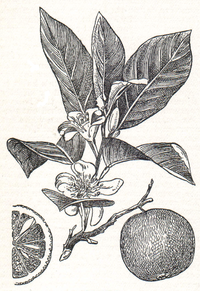Or'ange, the fruit of Curus aurantium and its varieties. To the same genus belong the limes, citrons, grape-fruits etc. All the species of the genus are natives of tropical and subtropical Asia, but are now extensively cultivated throughout the warmer regions of the world. In the United States orange cultivation centers in Florida, the delta region of the Mississippi and in California. Portions of Texas, New Mexico and Arizona are well-adapted for commercial cultivation. The orange was introduced into this country by the early Spanish explorers, here increased and formed wild groves of large extent. It is a long-lived tree, bears to a great age, is evergreen, and its glossy leaves are set off by snowy blossoms of exceeding fragrance. Blossom, green and ripe fruit may be seen at one time on the same tree. In cultivation it rarely exceeds 30 feet in height, and is a low-branching tree. It is attacked by various diseases, rot, blight and mould, and requires careful cultivation and watching. Scale insects have worked much damage to the orange crop. The red scale is kept in check by fumigating and by spraying. The white or fluted scale, formerly very destructive in California, has been practically vanquished by the Australian ladybird. Oranges are usually cut by hand and kept a few days before packing. There are numerous cultivated forms, the so-called navel oranges being an accidental variation. Among the commoner forms are the common sweet orange, a native of India, among whose most prized cultural forms are the Washington navel and Riverside navel; and the mandarin or kid-glove orange, a native of China, various cultivated forms being known as mandarins and tangerines.
